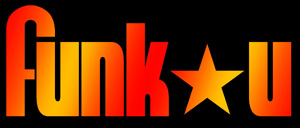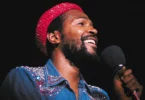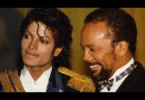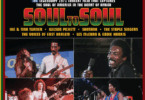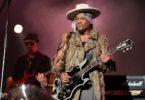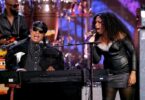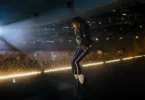Le site américain Wolfgang’s Vault vous propose d’écouter gratuitement un concert d’Herbie Hancock et des Headhunters enregistré au Newport Jazz Festival, le 2 juillet 1974. Vous pouvez également acquérir ce show pour la modique somme de $5 au format MP3 et de $7 au format Flac. Pour en savoir plus, rendez-vous ICI.
Line Up
Herbie Hancock – keyboards
Bennie Maupin – tenor sax, bass clarinet
Bill Summers – conga, percussion
Paul Jackson – bass
Mike Clark – drums
Communiqué officiel en anglais
After racking up a string of classy acoustic jazz recordings on Blue Note (beginning with 1962’s Takin’ Off and continuing with such all-time classics as 1964’s Empyrean Isle, 1965’s Maiden Voyage and 1968’s Speak Like a Child), pianist-composer-bandleader Herbie Hancock joined the Warner Bros. label and began flirting with electronics; first on 1969’s jazz-funk opus Fat Albert Rotunda and in an a more fully-realized sense on his experimental sextet outings, 1970’s Mwandishi and 1971’s Crossings. By 1972, Hancock felt the sextet (aka the Mwandishi band) had reached a peak and he was ready to go in a different direction that connected with a larger audience. As he wrote in the liner notes to the reissue to 1973’s groundbreaking Chameleon: “I began to feel that I had been spending so much time exploring the upper atmosphere of music and the more ethereal kind of far-out, spacey stuff. Now there was this need to take some more of the earth and to feel a little more tethered; a connection to the earth. The thing was, how could we take this music in a new direction by making it more palatable, but still keep this essence of our original philosophy? I wanted to actually do kind of a funk album. I didn’t know it was going to be a combination of jazz and funk at the time we started off. As it evolved, I liked what it was.”
Hancock’s touring crew (reed man Benny Maupin, percussionist Bill Summers, electric bassist Paul Jackson, drummer Mike Clark) took the stage at Carnegie Hall on this July 2nd concert with all the buzz afforded a group riding high on the strength of a popular album (initially released in October, 1973) that still garnered tons of radio during the summer of ’74. The crowd erupts with excited shouts to the opening strains of Summers’ instantly recognizable intro to “Watermelon Man” (in which he simulates the simultaneous singing/whistle playing of the Mbuti Pygmies of Northeastern Zaire). A radical reworking of a Hancock tune which originally appeared on his 1962 album Takin’ Off and later that year became a hit single for Mongo Santamaria, this funky version of “Watermelon Man” is fueled by the telepathic push-and-pull of the stellar San Francisco-based rhythm tandem of Jackson and Clark. Maupin plays the familiar melody on soprano while Hancock comps in funky, syncopated fashion behind him on Fender Rhodes electric piano.
Next up is a smoking jam on the driving “Sly,” a tune dedicated to Sly & the Family Stone, whose music (and in particular his hit single, “Dance to the Music”) had inspired Hancock to investigate this funk-fusion crossover music. Maupin stretches heroically on soprano sax while Jackson and Clark fuel the groove with Summers’ churning conga work and Hancock layers on his soulful accompaniment on electric piano. This version is broken up into two separate parts, the first showcasing Maupin on his searing, searching solo, the second allowing Hancock to wail over a percolating groove on electric piano while coloring the proceedings with synth strings from an ARP Odyssey.
During a spoken interlude, Hancock acknowledges his Chicago mentor Donald Byrd, who opened for Hancock with his band the Blackbyrds. As he tells the Carnegie Hall crowd, “I wouldn’t be here today if it wasn’t for Donald Byrd. Donald was the first guy I worked with. He brought me to New York, and from there everything happened. So… thank you, Donald Byrd!” Then while introducing the band, Hancock gives each member a little solo spot to shine before they collectively head into the ultra-funky, Hohner clavinet-driven “Spank-a-Lee,” a tenor sax feature for Maupin which the group would record the following month for Hancock’s 1974 album Thrust, his follow-up to the mega-successful Chameleon.
Hancock indulges the audience in a rap about his fear of bees as a prelude to “Hornets,” a frantic romp that appeared on 2003’s Sextant and features some wild blowing on soprano sax by Maupin and a solo shakere-chanting excursion by Summers against Hancock’s otherwordly synth coloring. Summers’ extended percussion jam segues smoothly into the familiar 12-note bass synth theme that triggers “Chameleon,” Hancock’s catchiest number and biggest hit. Along with some scorching tenor work by Maupin, Hancock erupts with some otherworldy synth soloing on this exhilarating set-closer.
Like his employer/mentor Miles Davis, Herbie Hancock is a musical chameleon who has continued to reinvent himself over five decades of music-making, zigzagging from acoustic jazz to avant-garde, funk-fusion, dance music, world music and pop music. Born on Apr 12, 1940 in Chicago, Ilinois, Hancock took up piano at age seven and by age 11 played the first movement of a Mozart piano concerto with the Chicago Symphony. After studying electronics at Grinnell College, he was recruited by jazz trumpeter Donald Byrd, who brought the young pianist to New York for the first time in 1961. The following year, Hancock debuted as a leader in his own right on Blue Note with Takin’ Off. In May 1963, Miles Davis asked him to join his band and he remained as part of the quintet for five years, appearing on a string of Davis classics including Seven Steps to Heaven, Four & More, My Funny Valentine, E.S.P., Nefertiti, Sorcerer, Miles de Kilimanjaro and Miles in the Sky.
A fusion pioneer, Hancock was one of the first to experiment with electronic effects and synthesizers, which he put to good use in his own esoteric sextet (with trombonist Julian Priester, saxophonist Benny Maupin, trumpeter Eddie Henderson, bassist Buster Williams, and drummer Billy Hart) and also with his funkified Head Hunters band. In the ’80s, his cutting edge projects with bassist-producer Bill Laswell (1983’s Future Shock, which included the MTV hit single, “Rock It”, 1984’s Sound System and 1988’s Perfect Machine) incorporated rappers, turntable scratching, sampling technology and world music elements.
His experiments in fusing electronic music and jazz continued with 2001’s Future 2 Future, and in 2007 his River: The Joni Letters, an intriguing interpretation of Joni Mitchell tunes, won the Grammy Award for Best Album of the Year. Hancock’s latest release is 2010’s ambitious
The Imagine Project, which was recorded in seven countries and features a host of collaborators, including Dave Matthews, Anoushka Shankar, Jeff Beck, the Chieftains, John Legend, India.Arie, Seal, P!nk, Juanes, Derek Trucks, Susan Tedeschi, Chaka Khan, Wayne Shorter, James Morrison and Lisa Hannigan. He was also named Creative Chair for the New Los Angeles Philharmonic. (Milkowski)
